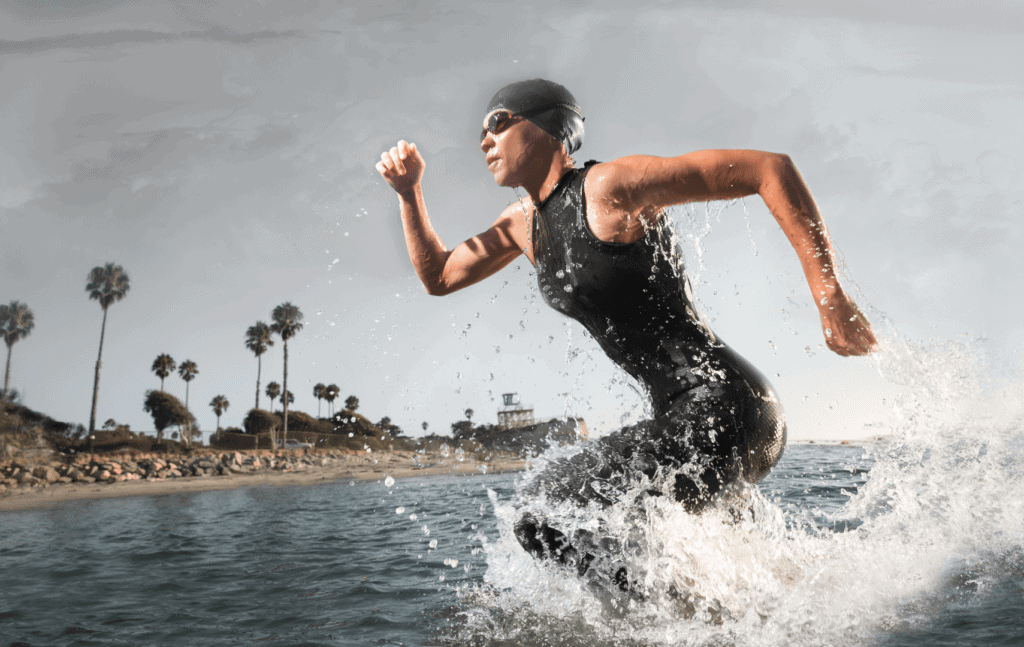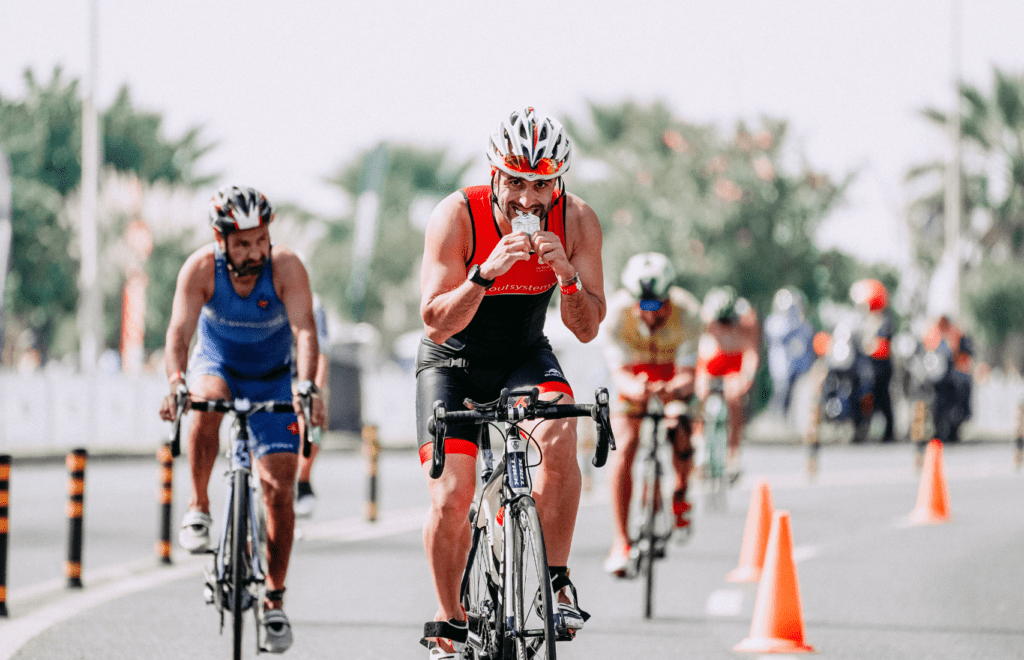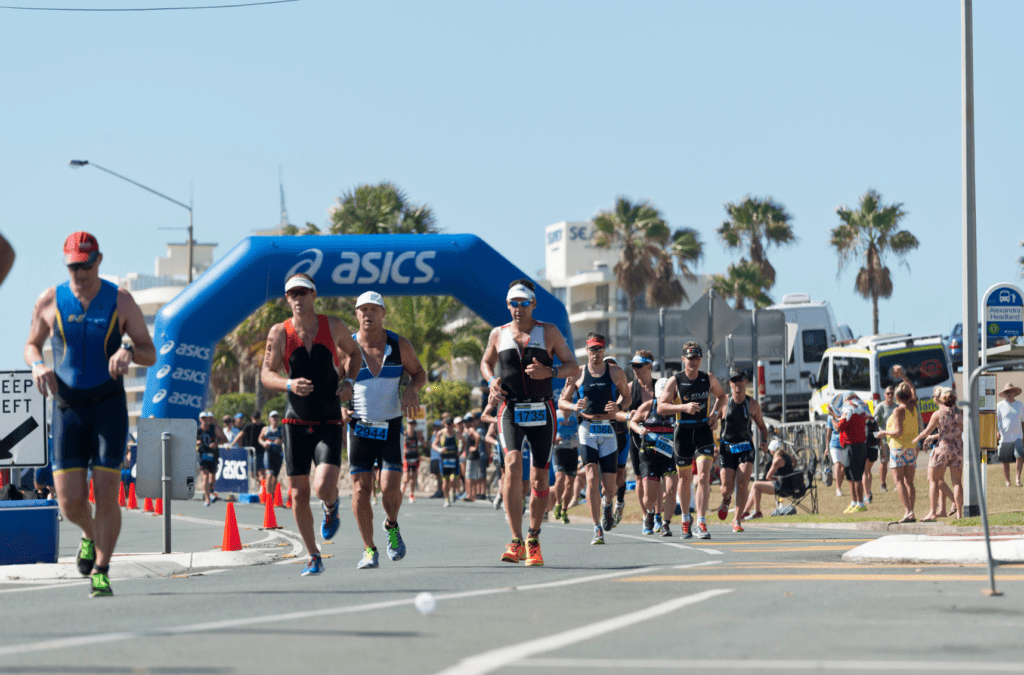
what to eat before, during & after
Table of Contents
If you recently signed up for an Olympic Triathlon, you need a good nutrition plan. This article will help you fuel yourself through the swim, bike and run!
The Olympic distance triathlon consists of a 1500 meter swim, 40k (~25 mile) bike, and a 10k (~6.2 mile) run. While the Olympic distance is considered a “short course” compared to longer Ironman races, it still takes an average of 3 hours to complete for recreational athletes. Not surprisingly, it’s very easy for athletes to fall victim to fueling pitfalls during that time.

The good news is that with preparation and practice, you can hone your race day nutrition plan and perform at your best.
Listen to the Greenletes Podcast to learn all about triathlon nutrition!
Should I carb load for an Olympic distance triathlon?
In the week or so before the Olympic distance triathlon, it’s a good idea to carb load. Eating extra carbs allows your body to store those carbs as glycogen, which may provide additional energy during the race.
Whereas most athletes eat 5-7 grams of carbohydrates per kilogram of body weight (2.2- 3.1 grams per pound) per day, aim to consume 10-12 grams of carbs per kilogram of body weight (4.5-5.4 grams per pound) per day.
For a 150-pound athlete, that’s a carb range of 682-818 grams per day.
Eating this amount of carbs may be difficult, especially with food alone. Carb-containing beverages, like sports drinks, juice, chocolate milk, coconut water, or oat/rice milk, are very helpful in getting you closer to your carb needs.
Breakfast: Quick/instant oats cooked in oat or rice milk, dried fruit, maple syrup/honey, greek yogurt or plant-based yogurt, peanut butter, glass of orange juice
Snack: Fresh or dried fruit, pretzels/cereal, sports drink
Lunch: Peanut butter & jelly sandwich with banana slices, chocolate milk or oat/rice milk
Snack: Clif bar or other cereal bar high in carbs (40+ grams carbs per bar), sports drink
Dinner: White rice, tofu, sweet potato, sauteed spinach and water OR pasta with tomato sauce, tempeh, roasted vegetables and water
Make sure you don’t eat anything new during race week, as this can upset your stomach!
What to eat the morning of a triathlon
All triathlon races start with the swim, followed by the bike and run. At least an hour before the swim, consume 1- 4 grams of carbs per kilogram of body weight (0.45- 1.8 grams per pound). A general rule of thumb is to match your grams of carbs with the number of hours before your activity.
For example, consume 2 grams of carbs per kilogram of body weight (0.9 grams per pound) 2 hours before activity. For the same 150 lb triathlete, this equals 136 grams of carbs 2 hours prior to the start of the race.
1. Peanut butter, jelly and banana sandwich with a sports drink
2. Bagel with peanut butter, honey, and banana with a sports drink
3. Two clif bars, large banana and sports drink
If you only have 60-90 minutes before the race to eat breakfast, opt for 1-1.5 grams of carbs per kilogram of body weight (0.45-0.68 grams per pound). For a 150 lb athlete, this means consuming between 68-102 grams of carbs for breakfast.
Here are three options:
1. Toast (15-20 g carbs) with peanut butter (3.5 g carbs per TBSP), honey (17 g carbs per TBSP), and large banana (30 g carbs), sports drink (~36 g carbs)
2. Bagel (52 g carbs), sports drink (~36 g carbs)
3. Clif bar (~40 g carbs), sports drink (~36 g carbs)
In order to figure out what feels good to you on race day, you’ll again need to experiment with different breakfasts on training days. If you’ve never been a big breakfast eater, you can train your gut to accept food and beverages in the morning.
Start slow with a little bit of food and drink and gradually progress the amount you consume over the next few weeks. It’s normal to feel nauseous at first, and it will usually improve with repetition as your stomach learns to empty faster.
How to fuel during the triathlon
The bike course (or in transition to the bike course) is the first time triathletes fuel during their race. It is a critical fueling period, as the bike is the longest portion of the race (average 1 hour 20 minutes), and all nutrition must be carried aboard the bike. No aid stations exist on the course.
During the cycle, consume 30-60 grams of carbs per hour. These carbs are necessary to maintain blood sugar levels for energy and performance.

In addition, drink 12-24 ounces of fluid per hour (~half to one water bottle per hour) to compensate for sweat losses and regulate body temperature. In addition to carbs and fluid, it’s important to consume sodium to replace the amount lost in sweat.
Triathletes are encouraged to consume 400-800 mg of sodium per hour, depending on individual sweat rates and race climate. Hotter temperatures cause more sweating and require more sodium consumption.
Here are three options:
1. 24 oz of Gatorade Endurance = 44 g carbohydrates & 720 mg sodium
2. 24 oz Skratch Labs mix = 30 g carbohydrates & 760 mg sodium
3. 2 gels = 44 g carbohydrates & 100-600 mg sodium (SiS Go Isotonic gels, Gu energy gel, Clif Shot energy gel)
If you’re using gels, use electric tape to adhere it to the bike tube at the line where you rip the gel open. That way, you only have to use one hand to open it, rather than stopping the bike to open with two hands.
The nutrition recommendations for fueling your run are the same as the bike: 30-60 grams of carbs per hour, 12-24 ounces of fluid per hour, and 400-800 milligrams of sodium per hour. However, the logistics are different than the bike.
Throughout the run course, every 1-2 miles, aid stations offer cups of water and gatorade (typically in ~6 oz cups). So instead of carrying your own fuel, you can rely on the aid stations. That said, try to train with the type of sports drink and gels that are offered on the race course.

How to set up your nutrition at transitions
Quick transitions between the swim, bike and run are key to competitive triathlon racing. Make sure your gels are already taped to your bike and water bottles are in your bike cages. Any gels or additional fluids should be laid out on your running gear where you’ll easily see them.
Know exactly where you’ll put these foods so that they are easily accessible during the run. Practice the transitions at least once or twice prior to race day.
How to recover after a triathlon
After completing an Olympic distance triathlon, it’s important to focus on recovery nutrition to refuel and repair your worn down muscles. You likely won’t be able to eat a full meal until you leave the race area, so try to eat a recovery snack as quickly as possible.
Food is often provided by the race organizers at the finish line. Try to eat some carbs and protein. For example, a bagel with peanut butter, a bag of pretzels, a piece of fruit and a protein bar, or anything that you can get your hands on.
Definitely include plenty of fluids and electrolytes in your recovery nutrition. Although you likely hydrated throughout the race, continue to do so for the rest of the day.
When you’re able to sit down for a meal, consume a balanced meal of carbs, protein, and fat. For example, rice, beans, veggies, and avocado. Recovery nutrition is extremely important for the next 24-hours, so continue to eat well-balanced meals throughout the day.
If you follow these tips and guidelines, you’ll crush your Olympic distance triathlon.
